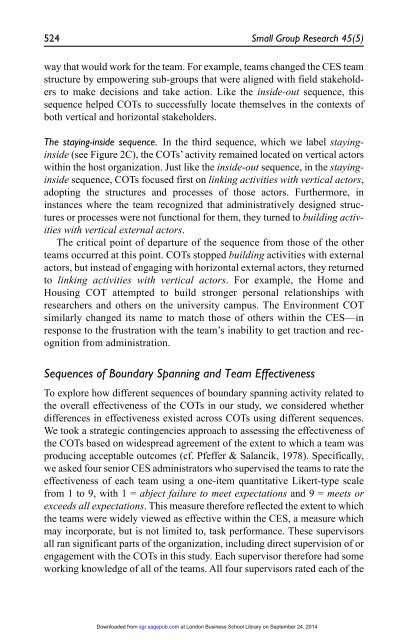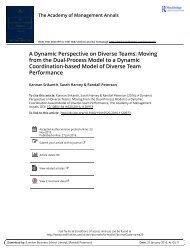The Process of Team Boundary Spanning in Multi-Organizational Contexts - Sarah Harvey, Randall S. Peterson, and N. Anand
Work teams must increasingly operate in complex environments characterized by multiple external actors beyond team and organizational boundaries. Although previous research demonstrates the importance of boundary spanning activities to team effectiveness, it reveals relatively little about the process of boundary spanning in these environments. In this article, we investigated the processes of boundary spanning across multiple external actors in 10 cross-organizational teams. We identified three sequences for reaching out to external actors: (a) moving inside-out from vertical actors inside the host organization to horizontal actors outside of the host organization, (b) moving outside-in from horizontal actors to vertical, and (c) staying-inside with vertical actors from the host organization. Our observations suggest that inside-out and outside-in sequences were more successful than simply pleasing the host organization. We build on our empirical findings to develop a process theory of how team boundary spanning activities across multiple external actors influence team effectiveness. Our research underscores the importance of a team’s interactions with actors in its external environment beyond those in an immediate supervisory role and provides insight into the dynamics of boundary spanning in multi-organizational contexts.
Work teams must increasingly operate in complex environments
characterized by multiple external actors beyond team and organizational
boundaries. Although previous research demonstrates the importance of
boundary spanning activities to team effectiveness, it reveals relatively little
about the process of boundary spanning in these environments. In this article,
we investigated the processes of boundary spanning across multiple external
actors in 10 cross-organizational teams. We identified three sequences for
reaching out to external actors: (a) moving inside-out from vertical actors inside
the host organization to horizontal actors outside of the host organization,
(b) moving outside-in from horizontal actors to vertical, and (c) staying-inside
with vertical actors from the host organization. Our observations suggest
that inside-out and outside-in sequences were more successful than simply
pleasing the host organization. We build on our empirical findings to develop
a process theory of how team boundary spanning activities across multiple
external actors influence team effectiveness. Our research underscores the
importance of a team’s interactions with actors in its external environment beyond those in an immediate supervisory role and provides insight into the
dynamics of boundary spanning in multi-organizational contexts.
Create successful ePaper yourself
Turn your PDF publications into a flip-book with our unique Google optimized e-Paper software.
524 Small Group Research 45(5)<br />
way that would work for the team. For example, teams changed the CES team<br />
structure by empower<strong>in</strong>g sub-groups that were aligned with field stakeholders<br />
to make decisions <strong>and</strong> take action. Like the <strong>in</strong>side-out sequence, this<br />
sequence helped COTs to successfully locate themselves <strong>in</strong> the contexts <strong>of</strong><br />
both vertical <strong>and</strong> horizontal stakeholders.<br />
<strong>The</strong> stay<strong>in</strong>g-<strong>in</strong>side sequence. In the third sequence, which we label stay<strong>in</strong>g<strong>in</strong>side<br />
(see Figure 2C), the COTs’ activity rema<strong>in</strong>ed located on vertical actors<br />
with<strong>in</strong> the host organization. Just like the <strong>in</strong>side-out sequence, <strong>in</strong> the stay<strong>in</strong>g<strong>in</strong>side<br />
sequence, COTs focused first on l<strong>in</strong>k<strong>in</strong>g activities with vertical actors,<br />
adopt<strong>in</strong>g the structures <strong>and</strong> processes <strong>of</strong> those actors. Furthermore, <strong>in</strong><br />
<strong>in</strong>stances where the team recognized that adm<strong>in</strong>istratively designed structures<br />
or processes were not functional for them, they turned to build<strong>in</strong>g activities<br />
with vertical external actors.<br />
<strong>The</strong> critical po<strong>in</strong>t <strong>of</strong> departure <strong>of</strong> the sequence from those <strong>of</strong> the other<br />
teams occurred at this po<strong>in</strong>t. COTs stopped build<strong>in</strong>g activities with external<br />
actors, but <strong>in</strong>stead <strong>of</strong> engag<strong>in</strong>g with horizontal external actors, they returned<br />
to l<strong>in</strong>k<strong>in</strong>g activities with vertical actors. For example, the Home <strong>and</strong><br />
Hous<strong>in</strong>g COT attempted to build stronger personal relationships with<br />
researchers <strong>and</strong> others on the university campus. <strong>The</strong> Environment COT<br />
similarly changed its name to match those <strong>of</strong> others with<strong>in</strong> the CES—<strong>in</strong><br />
response to the frustration with the team’s <strong>in</strong>ability to get traction <strong>and</strong> recognition<br />
from adm<strong>in</strong>istration.<br />
Sequences <strong>of</strong> <strong>Boundary</strong> <strong>Spann<strong>in</strong>g</strong> <strong>and</strong> <strong>Team</strong> Effectiveness<br />
To explore how different sequences <strong>of</strong> boundary spann<strong>in</strong>g activity related to<br />
the overall effectiveness <strong>of</strong> the COTs <strong>in</strong> our study, we considered whether<br />
differences <strong>in</strong> effectiveness existed across COTs us<strong>in</strong>g different sequences.<br />
We took a strategic cont<strong>in</strong>gencies approach to assess<strong>in</strong>g the effectiveness <strong>of</strong><br />
the COTs based on widespread agreement <strong>of</strong> the extent to which a team was<br />
produc<strong>in</strong>g acceptable outcomes (cf. Pfeffer & Salancik, 1978). Specifically,<br />
we asked four senior CES adm<strong>in</strong>istrators who supervised the teams to rate the<br />
effectiveness <strong>of</strong> each team us<strong>in</strong>g a one-item quantitative Likert-type scale<br />
from 1 to 9, with 1 = abject failure to meet expectations <strong>and</strong> 9 = meets or<br />
exceeds all expectations. This measure therefore reflected the extent to which<br />
the teams were widely viewed as effective with<strong>in</strong> the CES, a measure which<br />
may <strong>in</strong>corporate, but is not limited to, task performance. <strong>The</strong>se supervisors<br />
all ran significant parts <strong>of</strong> the organization, <strong>in</strong>clud<strong>in</strong>g direct supervision <strong>of</strong> or<br />
engagement with the COTs <strong>in</strong> this study. Each supervisor therefore had some<br />
work<strong>in</strong>g knowledge <strong>of</strong> all <strong>of</strong> the teams. All four supervisors rated each <strong>of</strong> the<br />
Downloaded from sgr.sagepub.com at London Bus<strong>in</strong>ess School Library on September 24, 2014
















